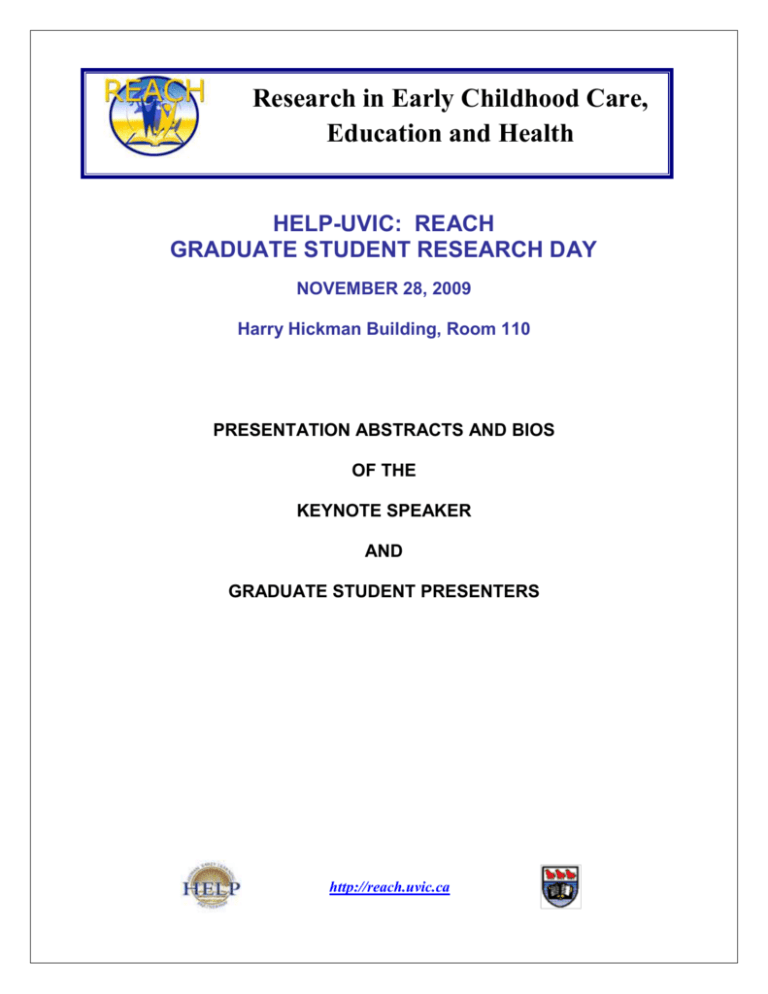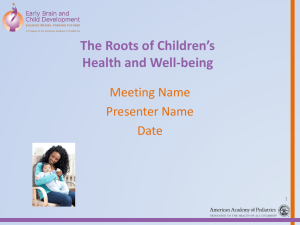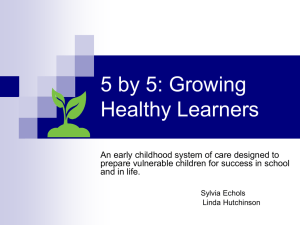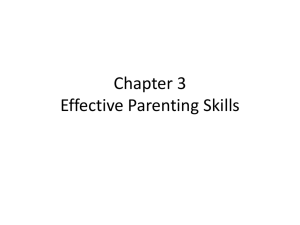here - University of Victoria
advertisement

Research in Early Childhood Care, Education and Health HELP-UVIC: REACH GRADUATE STUDENT RESEARCH DAY NOVEMBER 28, 2009 Harry Hickman Building, Room 110 PRESENTATION ABSTRACTS AND BIOS OF THE KEYNOTE SPEAKER AND GRADUATE STUDENT PRESENTERS http://reach.uvic.ca KEYNOTE SPEAKER ENID ELLIOT, PhD Moving Early Childhood Outdoors: Tensions and Possibilities in Making Space Place Together with Natasha Blanchet-Cohen, PhD, this research grew out of the interest of four centres to focus on their outside playspaces. While each program recognized that the children enjoyed being outside each had a different vision and a different landscape. There were initially three centres joined by a fourth one later. An informal discussion group eventually became a research project. Included in their discussions were the local licensing office, the provincial head of licensing, and a landscape architect. Their research included conversations with children, as well as with the educators. Through listening closely, videotaping and observing children and educators, their perceptions of being and acting outdoors were explored with them. The children shared their thoughts by showing the researchers around their outside environment, watching and commenting on their videos, looking at their photos and by their actions outside. With concerns for the environment and for children’s health and learning there has been a growing interest in play out of doors (Trevarthern, 2008). Outdoor plants, rocks, dirt, and trees can afford children unlimited opportunities of exploration, discovery and play. Having the opportunity for holistic learning and establishing relationships with all things of the earth (Lester & Maudsley, 2007), children begin to incorporate their experience outside into a sense of place. From interviews, conversations and observations, children seemed engaged and enthusiastic about being outside. Educators felt children were relaxed outdoors having different relationships with each other and with the educators. Drawing on their own childhood experiences, educators felt positive about the possibilities of engaging children with the natural world. All the educators experienced tensions in their roles outdoors. Much of this tension centred on safety issues, their perceptions of safety, their beliefs around children’s learning and the regulations set in place by the local licensing authority. The First Nations program was concerned about cultural safety in their outdoor setting, wanting to create culturally appropriate play areas outside that might not meet licensing standards. Attempting to anticipate all possible accidents, regulations are reflective of the fears prevalent in society. Regulations perceive the role of the educator as an adherent and enforcer of regulations and perceive children as in need of protection. Educators hold different views and beliefs about safety, their role and about children’s capability. Meanwhile, children are developing their own concept of safety and its meaning in their lives. There are multiple plateaus (Deleuze & Guattari, 1987) coinciding and colliding. Designing an outside space requires negotiating these tensions around safety. Educators, aware that children can have qualitatively different experiences outside, balance providing experiences for children with satisfying licensing regulations. Two of the programs began to make changes to their outside space with plans for more. A natural playspace provides an opportunity for children to begin to discover who they are in relationship to the trees, plants, and terrain of their local environment. References: Deleuze, G., & Guattari, F. (1987). Minneapolis: University of Minnesota Press. Lester, S., & Maudsley, M. (2007). Play, naturally: A review of children's natural play. London: National Children's Bureau. Trevarthern, C. (2008). Land and freedom. Children in Scotland(84), 8-9. Bio: Enid Elliot, Ph.D, has been an early childhood educator for many years now. She has worked in Turkey, California, New York and British Columbia in a variety of contexts and programs. Over the years of working in this field she finds herself continually surprised, intrigued and inspired by the children, families and early childhood educators with whom she engages. Babies and toddlers are a particular source of joy and inspiration. Going back to do a doctorate helped develop different perspectives on that inspiration and her doctoral dissertation resulted in a book, We’re not robots: Listening to the voices of daycare providers. Currently she is working with a group of educators on naturalizing outside playspaces. Together they reflect on the impact of outside play, the educators’ role and the influence of the outside world. As chair of the Greater Victoria Regional Child Care Council she continues to advocate for a sensible system of child care for our children. HELP-UVic: REACH Graduate Student Research Day November 28, 2009 Page 2 GRADUATE STUDENT PRESENTERS MICHAEL MILLER (PSYCH) The Configuration of Executive Function in Preschool Children Executive function (EF) refers to higher mental processes that are involved in the conscious control of actions and thoughts. Although there is general agreement about the importance of EF for adaptive purposes (e.g., social understanding, school readiness and achievement), the nature of EF has remained elusive. In particular, it remains unclear whether EF in preschool children is a unitary construct or whether it is composed of a number of separable processes. The present study used advanced statistical techniques in order to (a) assess the factor structure of EF in preschoolers, and (b) examine the contribution of EF to preschoolers’ problem-solving abilities. A sample of 129 children between 3 and 6 years of age completed a battery of EF tasks. Confirmatory factor analysis was used to determine the factor structure of EF. A two-factor model consisting of working memory and inhibition fit the data better than a single-factor model. Findings are discussed in terms of selecting observable measures that are appropriate to capturing EF in preschoolers. Bio: Michael Miller is a graduate student in the Life Span Developmental Psychology program in the Faculty of Social Sciences at the University of Victoria, working with Dr. Ulrich Müller. His research interests include infant and child development, social understanding, executive function, humour development, gender role development, and school readiness. Currently, Michael is working on his doctoral dissertation proposal on the topic of humour development and social understanding in early childhood. He hopes to begin collecting data for his dissertation in the spring of 2010. EMILY CARTLEDGE (PSYCH) Understanding Peer Victimization in Preschoolers: The Role of Emotional Competence Peer victimization is the experience of an unprovoked, repeated display of aggression by a more powerful peer (Eisenberg & Aalsma, 2005). Peer victimization is a significant problem reported in numerous countries (Griffin & Gross, 2004) and Canada’s prevalence ranking compared to other countries has deteriorated in recent years (Craig & Pepler, 2007). Emotional competence skills, including emotion regulation and emotion understanding, can be viewed as intrinsically linked to peer victimization episodes, as emotional reactions are constantly being monitored and altered during social interactions. Helpful in understanding peer victimization, Lemerise and Arsenio’s (2000) social information processing model outlines the emotional and cognitive processes children use during social interactions. Emotion regulation skills are seen as a key feature of children’s psychological development and play an important role in developing social competence. The goal of Emily’s ongoing research is to elucidate the relation between preschoolers’ emotional competency skills and their involvement in peer victimization episodes. The study of emotional competencies in relation to peer victimization in preschoolers can help recognize problematic emotional control strategies used during peer interactions, and will therefore contribute to the development of early prevention and intervention programs. This study will provide important information about the relative contributions and interplay of emotionality, emotion understanding, and emotion regulation in the prediction of peer victimization. Bio: Emily Cartledge obtained her Bachelor of Science degree in Psychology in 2007 from the University of Ottawa. She is currently in my second year of the Master of Science program in Clinical Psychology (emphasis in Life-Span Development) at the University of Victoria. Her research focuses on peer victimization and emotional competence in preschoolers. Emily is also interested in predictors of social behaviour problems in preschool bullies and the development of executive function and theory of mind. HELP-UVic: REACH Graduate Student Research Day November 28, 2009 Page 3 SARAH HUTCHISON (PSYCH) Executive Function and the Bilingual Experience An emerging topic in cognitive development is whether being bilingual constitutes an advantage for children’s performance on executive function tasks (Bialystok, 2001). Executive function (EF) broadly refers to cognitive processes such as working memory, inhibitory control, and cognitive flexibility that are involved in the conscious control of action and thought (Garon, Bryson & Smith, 2008). EF is important for development because EF has been implicated in various developmental disorders such as Autism and Attention-Deficit Hyperactivity Disorder (Zelazo & Müller, 2009). Studies on the relation between bilingualism and EF have shown that bilingual children perform better EF tasks (e.g., Bialystok, 1999). However, extant research suffers from three shortcomings. First, the majority of studies focus on the inhibitory control aspect of EF. As a result, it is not clear whether the bilingual advantage is also manifest in other aspects of EF. Second, previous studies have rarely assessed children’s proficiency in both languages. As a result, it is unclear how proficiency affects the bilingual advantage (Morton & Harper, 2007, Bialystok, 2008). Third, language exposure is rarely assessed. However, the assessment of language exposure is important because different patterns of language exposure may have different ramifications for the development of EF. Sarah’s proposed study will address these three shortcomings of extant research and thus provide more detailed information about the effects of bilingualism on the development of EF. Bio: Sarah Hutchison received a BA in Psychology from Athabasca University through Mount Royal University in 2008. She is currently a graduate student in the MSc Life-Span Developmental Psychology program at the University of Victoria. Research interests include the development of executive function in bilingual preschoolers, the neural basis of language in bilinguals, social understanding, and selfregulation. CHRISTINE HOCHBAUM (SOC) Child Health Status as a Correlate of Child Behavioural Outcomes: The Mediating Effect of Parenting Style The purpose of this investigation is to test the mediational effect of parenting style on the association between child health status and child behavioural outcomes in children. Using cross-sectional data of children 4 and 5 years old from National Longitudinal Survey of Children and Youth (NLSCY) Cycle 4 2000-2001, the paper explores the degree to which child health status is related to child behavioural outcomes. In addition, the present study investigates the extent to which child health status is linked to parenting style. Another aim of this study is to explore the association between parenting style and child behavioural outcomes. Child outcome measures assessed in this study include: hyperactivity-inattention, emotional-disorder anxiety, conduct disorder—physical aggression and indirect aggression. Child health status is assessed using the Health Utility Index Mark 3. The Health Utility Index gives a description of an individual’s overall functional health, founded on eight attributes that include: vision, hearing, speech, mobility, dexterity, cognition, emotion, pain and discomfort. Parenting style is measured using several parenting scales that consist of: positive interaction, hostile/ineffective parenting, consistent parenting, and rational (punitive/aversive) parenting. Statistical analysis was conducted using Ordinary Least Squares (OLS) and logistic regression to test the conceptual model and the significance of relationships between the variables of interest. There was partial support for the mediational model of parenting style on the association between child health status and children behavioural outcomes. Specifically, both ineffective and rational parenting each showed a mediational effect. Child health status and child behavioural outcomes were found to have a strong relationship to each other. However, ineffective parenting was more strongly related to child behavoiural outcomes than child health status. This suggests that children that are exposed to ineffective parenting are at greater risk for developing behavioural difficulties than children receiving other forms of parenting. Moreover, children who receive this type of parenting and have poorer health are at even greater risk for developing these behavioural problems. However, these conclusions are tentative as the directionality of these relationships is uncertain because of the cross-section design of this study. HELP-UVic: REACH Graduate Student Research Day November 28, 2009 Page 4 Bio: Christine Hochbaum is currently pursuing her Doctorate in Philosophy specializing in Sociology at the University of British Columbia. Christine obtained a Master of Arts degree in Family Studies at the University of British Columbia. Her proposed dissertation research will be an expansion on the work she completed at the Master’s level. Christine’s research interests centre on the sociology of health and disability with particular focus on mental health, stigma, deviance, impairment, disability, and social determinants of health. In addition, she is interested in the sociological study of the family with special attention given to parenting, parental stress, parent-child interaction, family functioning, family resilience, and the community context in which the family is embedded. RACHEL MARK (EPHE) Testing the Effectiveness of Interactive Game Bikes on Physical Activity Motivation among Parents and Young Children in the Home: An Intervention Study Background: Over 51% of adults and 57% of children ages 5-17 are not currently active enough to reap the health benefits associated with regular physical activity (PA) 1,2. While numerous self-regulatory interventions have been introduced with the hopes of improving participation, they have proven to have only a modest effect3. Interactive video games (particularly interactive stationary bikes) are PA initiatives that provide positive affective experiences and physiological benefits 4,5, however prior research has been limited to adult populations within laboratory settings. This pilot study sought to overcome these past limitations by examining usage of GameBikes (GB) in comparison to traditional stationary bikes (SB) among families (parents and children) in the home-setting and including a validated theoretical frame to understand motivation for their use (i.e., Theory of Planned Behaviour). Method: Following CONSORT protocol for randomized, controlled trials, families were randomized to receive a GB or a SB and kept the equipment for six weeks. After all family members had a ten minute trial with the bike; parents completed questionnaires (T1) and then repeated them after six weeks (T2). Usage by all family members was tracked using logs. Following the trial, belief elicitation was performed with families of the GB group. Results: Repeated measures (RM) ANOVA for frequency of use among parents and children yielded a large time effect (F5,34 = 3.15, p < .05; η2 = .32) with post-hoc analysis suggesting a decrease in usage by both groups over time creating a large, significant effect for SB (t18 = 3.77, p < .01; d = .89) and a small effect for GB (t20 = 1.02, p = .32; d = .32). SB had higher usage during week one than GB yielding a medium effect (t38 = -2.17, p = .04; d = .55), whereas GB had higher usage at week 6 yielding a small effect (t38 = 1.35, p = .19; d = .36). In addition, parents in the GB condition increased the proportion of those meeting Health Canada’s PA guidelines by 33.3% compared to an 8.34% increase for SB, yielding a medium effect size difference (h = .51) across the trial. RM ANOVA for affective attitude (AA) of parents yielded a large effect for both time and intervention effects (F1,22 = 32.73, p < .01, η2 = .60; F1,22 = 8.54, p = .01, η2 = .60 respectively). Both GB (t11 = 6.08, p < .01, d = 1.67) and SB (t11 = 3.27, p < .01, d = .88) lowered across time, but GB experienced higher levels of AA at both T1 (t25 = 2.69, p < .01, d = 1.55) and T2 (t22 = 2.58, p < .05, d = 1.39). Elicited behavioural beliefs were primarily affective- and controlbased and concerned the equipment and sizing for children as some children were too small to use the bike. Conclusions: From this investigation it can be noted that usage decreases less rapidly with the GB than with the SB for parents and children. As well, the difference in AA between groups highlights the importance of AA in PA interventions. This study provides support for the use of interactive video games by both adults and children to augment current physical activity initiatives. As effect sizes for this pilot study were classified as medium and large, it is suggested that larger powered trials be initiated. As well, future studies may wish to use equipment built for specifically for children such as the Fisher Price Smart Cycle. References: 1. Canadian Fitness and Lifestyle Research Institute (2005). Physical Activity Levels Among Canadian Adults. Retrieved Feb 2, 2008 from http://www.cflri.ca/eng /levels/adult_levels.php 2. Craig, C.L., Cameron, C., Russell, S.J., & Beaulieu, A. (2001). Increasing physical activity: Supporting children’s participation. Ottawa, ON: Canadian Fitness and Lifestyle Research Institute. 3. Rhodes, R.E. & Pfaeffli, L.A. (2009). Mediators of behaviour change among adult non-clinical populations: A review update. Annals of Behavioral Medicine, 37, s85. 4. Warburton, D.E.R., Bredin, S.S.D., Horita, L.T.L., Zbogar, D., Scott, J.M., Esch, B.T.A. et al. (2007). The health benefits of interactive video game exercise. Applied Physiology, Nutrition and Metabolism, 32, 655-663. 5. Rhodes, R.E., Warburton, D.E.R. & Bredin, S.S.G. (in press). Predicting the effect of interactive video bikes on exercise adherence: An efficacy trial. Psychology, Health and Medicine. HELP-UVic: REACH Graduate Student Research Day November 28, 2009 Page 5 Bio: Rachel Mark is currently a Master’s student of Dr. Ryan Rhodes in the School of Exercise Science, Physical and Health Education. She graduated from the University of Calgary in 2007 with a Bachelor’s degree in Kinesiology and moved to Victoria later that year to begin graduate work at the University of Victoria. She is currently finishing her thesis and will defend in December. Her research area has been interactive video games and family physical activity. Outside of school, Rachel enjoys yoga and spending time with friends. She is currently completing yoga teacher training and is planning a trip to Mysore, India next year to study with master teachers there. CINDY LAU (HDLC) “Let Us Tell You About It”: Parent-child Evaluation of a Preschool Readiness Programme The Welcome to Kindergarten Programme is part of an early-learning literacy initiative. The purpose of the programme is to enhance children’s learning experiences just before school begins, and to encourage families to participate in their children’s early education. Children are provided with a bag of schoolrelated materials in May of the year just before they are due to enter kindergarten. The idea is that they will work and play with the materials at home over the summer with their caregivers. By engaging children in meaningful and academically oriented activities with caregivers prior to their regular school attendance, they are expected to build a familiarity with, and expectations for, formal education. Sponsored by HELP and in conjunction with the Vancouver School Board, program evaluation was conducted in Vancouver schools. In order to improve and ensure the sustainability of the program, parents and children were invited to take part in the evaluation process. Parents were engaged in an initial telephone interview which was followed up with parent-child joint interviews at their local kindergartens. Sixteen families completed both the phone and face-to-face interviews. In the parent-child interview, parents were encouraged to serve the role of interviewers (with back-up from the researcher), and they invited children to use the materials as they had done at home. Their interactions were videotaped and transcribed for analysis. Both parents and children thought that getting hands-on experience with educational materials before school was beneficial. They also made some suggestions for the program; for example, including games and problem-solving activities, books with social and emotional content, and more information about the school to help parents (especially immigrants) gain a better understanding of Canadian school expectations. This methodology differs from other evaluations in that parents guide their own interviews and frame questions to meet their own children’s needs. Children had the materials in front of them to help them situate their perceptions, demonstrate their involvement with the materials, and express their thoughts. Consequently, researchers have richer and more in-depth information that is beyond what might have been available from standardized surveys and interviews. Moreover, based on our observations, childparent collaboration and engagement in learning has emerged as another key to successful transition to school. Future research can consider employing this joint parent-child interview approach to increase interview reliability with young children, and inspect how parent-child collaborations mediate the exploration of learning in out-of-school contexts. Bio: Cindy Lau earned her Honours Bachelor of Science degree in Psychology from the University of Toronto, and is currently reading for her Masters degree in Human Development, Learning, and Culture at the University of British Columbia. Having been born and raised up to her early teenage years in Hong Kong, and having experienced a diversity of cultures in Canada, she was led in the direction of crosscultural research, and became interested in the socio-cultural impacts of bi-cultural experiences on children’s development and education. As part of Dr. Ann Cameron’s research team, Cindy became involved in numerous research projects related to youths’ resilience, children’s moral development and education, and young children’s school readiness. Her goals are to enhance the current preschool curriculum through her research studies, pursuant to which she has begun to develop culturally and developmentally appropriate, evidence-based applications that could build strong and positive homeschool connections to foster early childhood development. HELP-UVic: REACH Graduate Student Research Day November 28, 2009 Page 6 ANDREA K. TITTERNESS (MED) Ethanol and stress: Independent or compounding culprits? Background: Animal models of fetal alcohol syndrome (FAS) have shown that prenatal ethanol exposure (PNEE) can impair long-term potentiation (LTP), a putative mechanism behind learning and memory, in the hippocampus of adult males. Interestingly, prenatal stress, like PNEE, can also reduce the capacity for LTP in male offspring. Surprisingly, it is unknown how either PNEE or prenatal stress affect LTP in the hippocampus of females. The goals of the current study were to 1) investigate how PNEE affects LTP in female offspring and 2) determine if prenatal stress compounds the effects of PNEE on long-term potentiation in male and female offspring. Methods: Pregnant Sprague-Dawley rats were assigned to one of three feeding conditions on gestation day 1 (GD1): 1) ethanol (E): ad libitum access to a liquid diet containing 35.5% ethanol derived calories; 2) pairfed (PF): liquid diet similar to E dams containing maltose-dextrin instead of ethanol; dams received the same amount of food in g/kg/day as matched E dam; 3) control (C): ad libtum access to standard rat chow. E, PF and C dams were further separated into a prenatal stress treatment (3, 45-min restraint sessions/day during GD12-21) or non-stress treatment (remained undisturbed in home cage). LTP was assessed in the dentate gyrus of male and female offspring between postnatal days 30-35. Results: PNEE reduced LTP in male offspring compared to C males but enhanced LTP in female offspring compared to C females. Surprisingly, prenatal stress did not reduce LTP in male offspring, regardless of prenatal diet. In contrast, prenatal stress did reduce LTP only in females following PNEE. Conclusions: These results indicate that hippocampal function in males and females is differentially affected by PNEE. Furthermore, females, but not males, are sensitive to the deleterious effects of prenatal stress on LTP. Bio: Andrea Titterness is currently a Doctoral candidate in the Neuroscience program through the University of British Columbia. Her supervisor Brian Christie, an Associate Professor and Michael Smith Senior Scholar, has joint appointments through UBC and the University of Victoria. With UBC, he is associated with the department of Cellular and Physiological Sciences and the Brain Research Centre. At the University of Victoria, Brian is associated with the Division of Medical Sciences. B. DENISE HODGINS (SCYC) Exploring Children’s Perspectives of Father Involvement: An exploration of children’s understanding of the construction of gender This presentation will introduce the beginning stages of a research project that seeks to better understand children’s perspectives of father involvement. Mounting evidence demonstrates that father involvement has a positive impact on children, mothers, fathers, families and society in general. Due in part to this recognition, father involvement has received increased attention in Canada in recent years. To date, however, little research has explored father involvement from the perspective of young children. This anticipated research project will use pedagogical narration as a methodology to research with children and explore their understanding of father involvement through a gender construction lens. Positioning fathers as gendered subjects and including children’s perspectives has enormous potential to add to current father involvement theories. This study also has the potential to add to the field of applied practice by exploring the area of fatherhood within early childhood education and care settings using pedagogical narration as a method to generate knowledge with children. Bio: Since 1989, Denise Hodgins has worked with children, youth, parents and educators in a variety of capacities: a school age child care provider, a preschool teacher, a workshop facilitator, and a director of a non-profit organization providing prevention and support programs to children, youth and families. She holds a Masters of Education degree in Early Childhood Education from the University of Victoria. Denise’s current work as a Doctoral student in the School of Child & Youth Care at the University of Victoria focuses on supporting positive father involvement in parenting young children. She is particularly interested in children’s perspectives of father involvement and the role that gender plays in the (re)construction of parenting practices. As a co-parent of two young children, Denise engages in the evolving, changing, joyful and challenging dance of parenting on a daily basis. HELP-UVic: REACH Graduate Student Research Day November 28, 2009 Page 7 KATHLEEN KUMMEN (SCYC) The Ethics of Disruption: Supporting Pre-service Early Childhood Teachers in Developing and Engaging in Reflexive Practice The purpose of this presentation is to highlight aspects of Kathleen’s Doctoral research which explores how to support pre-service teachers in reflecting on their own image, and how that image connects to their understanding of theory and practice in early childhood education. The critical role of reflexivity as a pedagogical practice in early childhood education is well documented (for example, Curtis and Carter, 2008, and Rinaldi, 2005), yet there is very little research that has explored how early childhood education training programs can support pre-service teachers in developing and engaging in reflexive practice to disrupt dominant discourses that act as barriers to the implementation of quality care and education for young children. By inviting her students to explore practices such as critical reflection, reflexivity and deconstruction, she hopes to create ethical encounters that will disrupt the dominant discourses that students hold, so that they can be open to other perspectives or ways of understanding teaching. Kathleen hopes to create the conditions with her students that support them to “attend to the politics of what we do and do not do at a practical level” (Lather, 1991 p. 13) as they connect discourses to practice. Bio: Kathleen Kummen has worked in the field of early years for over 25 years. She has held a variety of positions including working as an early childhood educator, child life therapist and child care licensing officer. She is presently a faculty member in the Department of Early Childhood Care and Education, Faculty of Health and Education, Capilano University, and is a sessional instructor for the School of Child and Youth, University of Victoria. Kathleen is also a PhD student at the School of Child and Youth Care, University of Victoria. As a graduate student, she is part of Research in Early Childhood Care, Education and Health (REACH), a consortium of early childhood researchers at the University of Victoria. Kathleen’s research interests focus on in exploring theory and practice in the pre-service training and ongoing professional development of early childhood educators. ALEXANDRA BOMPHRAY (EDUC) Considering English language learners’ peripherality and legitimacy in small group discussions about graphic novels This qualitative, descriptive case study examines the role literacy practices play in relation to the degree of English language learners’ (ELLs’) community acceptance. One specific literacy practice—the use of a multimodal literacy approach anchored in graphic novels—will serve as a focusing lens to investigate the larger complexities of ELLs’ membership and acceptance. This study will provide insight into how a multimodal teaching approach anchored in graphic novels can be used as an instructional tool to enhance ELLs’ peripherality and legitimacy in small-group literacy discussions. Bio: Alexandra Bomphray is a PhD candidate in Educational Studies at the University of Victoria. Her research interests include the use of multimodal teaching strategies, English language learners’ instruction and learning, and classroom community membership and acceptance. After teaching elementary school for several years, Alexandra received her master’s degree in Literacy, Language, and Culture from the University of Michigan. She currently is a sessional instructor in the Elementary Education Program at the University of Victoria. HELP-UVic: REACH Graduate Student Research Day November 28, 2009 Page 8








